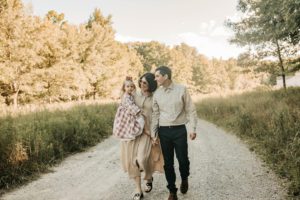Before you read on, make sure you have read Part 1 of our interview. In Part 1, Bridget discusses what STXBP1 disorders are and the diagnostic journey her family went through to get a diagnosis for her daughter. Today, we’ll be discussing what it’s like to grapple with a diagnosis; fundraising through “FLOURISH”; and advice for other families.
Grappling with the STXBP1 Diagnosis
The first few weeks following Flo’s diagnosis were difficult to deal with. Looking at Flo, Bridget wasn’t able to see the defining symptoms that the genetic counselor had given her to look out for. She was confused by the genetic counselor’s assertion that Flo seemed to have a mild case of STXBP1. Although Bridget joined the Facebook groups, they were somewhat overwhelming at first: a lot of unstructured information and emotions from people at different stages of their journey.
Yet these groups and this research did help the Finn Beaubien family because it put them on the path to learn about, and get in contact with, Dr. Ingo Helbig at the Children’s Hospital of Philadelphia (CHOP). Sam and Bridget reached out to CHOP and ended up scheduling a visit for just a few weeks later. Booking a 24-hour EEG in advance of the visit to get a baseline of what was happening neurologically with Flo. Bridget explains that this is important as Flo doesn’t currently have seizures, but the family and all of Flo’s medical providers wanted to be prepared in case anything changes. She shares:
“There was a period of time where we lived in fear every day that the seizures would appear and may never go away. She doesn’t currently have seizures and we’re learning to live around the fear. But the grief doesn’t go away.”
At two years old, Flo now undergoes 20 hours of therapy each week, including ABA, speech therapy, physical therapy, and occupational therapy. While epilepsy specialists typically know of STXBP1 or something like it, Bridget often finds herself explaining what it is to doctors and therapists, something she knows is fairly common within the rare disease community.

Flo is also not currently on disease-altering treatment because it does not yet exist. Doctors suggest that Bridget and Sam help her to build the maximum number of skills while her brain is still young and malleable. Says Bridget:
“Honestly, the most important thing to us is her happiness. And she is the happiest girl. She’s just incredible. Flo started crawling a few weeks ago and is off like a dirty shirt. She only started sitting up on her own about six months ago and to think that there were only about five months between that and crawling is incredible to me. She reaches out to people. The amount of growth that she’s shown has just blown my mind. We celebrate inch-stones. We don’t know if she’ll be verbal, but she can communicate her own needs. She’s a firecracker. I love her and am so amazed by her.”
FLOURISH
As Bridget and Sam learned more about STXBP1, they were also faced with an unsettling reality: no treatments or cures exist. They began speaking with other parents within this community and became motivated to contribute to the efforts forged by other parents and caregivers. Bridget shares:
“There is such an amazing group of parents and caregivers within STXBP1, and I’m so inspired by what they’ve been able to accomplish. Ben and Erin Prosser are the parents of a wonderful child named Lucy who has STXBP1, they raise funds for research via Lulu’s Crew. Ben is a scientist and has a lab at UPenn and has a potential treatment in the pipeline. Another dad, Mike Boland, is a molecular biologist with expertise in human stem cell technology, transcriptomics, and developmental neurobiology runs a lab at Columbia University and does CRISPR research. These parents are so deeply engaged and working so hard for all of our kids. I feel so indebted to all of the parents who have arrived at this diagnosis before us. I wanted to be more helpful to this mission.”
As she began speaking with various parents and advocacy group members, Bridget learned a harsh reality for many people within the rare disease community: the lack of funding. Within rare disease communities, fundraising is difficult. Pharmaceutical companies often don’t develop rare disease drugs due to a lack of awareness around the conditions and the seemingly small number of those affected. Bridget was shocked and frightened to think that there might not ever be a cure for STXBP1 because of a lack of fundraising and visibility:
“There are so many diseases that are closely linked. Yes, it would take significant amounts of funds to cure certain diseases. But if you make ground on one, you can make ground on others. I have a background in fundraising and contemporary art. So I decided to use the platform I have to bring visibility to this. I contacted a few artists who came on board, then planned to do an auction in September since its STXBP1 Awareness Month. Christie’s then came on board to do the auction. Everyone I’ve asked has been so generous and responsive. The goal is that between the auction and the cash fund, we’ll raise enough money to fund a natural history study that will hopefully lead to clinical trials and, eventually, viable treatments when the time comes.”
These studies will also assist with helping the STXBP1 community to have its own, individualized data that can be used to better understand the disease spectrum, profile, and how to respond to it. Through this data, Bridget hopes the foundation will eventually have the power to help get a treatment approved by the FDA. She hopes (and believes) that this will happen during Flo’s lifetime.
In the end, Bridget is so thankful for everyone who has reached out and helped her during this time, for every bit of outreach. She says:
“I wish I had known before about how present rare disease is, how small but connected these communities are, and how they really need help, visibility, and support. Now that I know, it can sometimes feel overwhelming trying to figure out where to go next or what to do. But when I feel overwhelmed, I remember how hard Flo works and how parents who didn’t have a diagnosis were persistent for answers. I want to support all of those who have fought for change.”
Advice for Others
The rare disease journey can be overwhelming, frightening, and full of emotions – but you don’t need to go it alone. Bridget reminds people that although a diagnosis can be hard to deal with, it is actually a good starting point. She explains:
“You’ve done so much and gone so far. I know it doesn’t feel like that at the moment, but you have a diagnosis and you can pursue interventions. You can live. You can figure out your ‘what’s next’ and how to get there. That’s not easy to do and it can take varying amounts of time to feel like anything is going to be alright. And right now, maybe it’s not alright, but at least you know and you can make plans. You have to be in the moment. Give yourself time.”
She also shares that coming to terms with a diagnosis and grappling with changing expectations can be one of the hardest parts of the process. At one point, her mother even told her that she can’t live in fear of Flo’s symptoms and of STXBP1. Bridget shares that that snapped her back into action:
“As I processed, I realized that it was our expectations, mine and Sam’s, that had to change. Our expectations left us feeling so devastated by Flo’s diagnosis. Flo is who she always was. She is happy and living a great life, and we’re so happy to provide that for her. Learning how to step back and reevaluate can bring you a lot of peace.”



